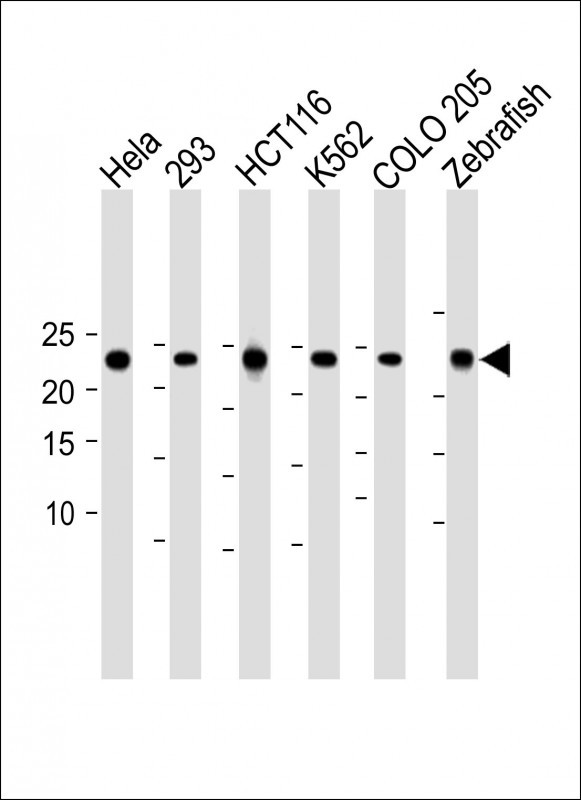Mouse Rpl13a Antibody (N-term)
Affinity Purified Rabbit Polyclonal Antibody (Pab)
- 产品详情
- 实验流程
- 背景知识
Application
| WB, E |
|---|---|
| Primary Accession | P19253 |
| Other Accession | P35427, Q95307, Q4R8Z2, P40429, Q3SZ90, NP_033464.2 |
| Reactivity | Mouse |
| Predicted | Bovine, Human, Monkey, Pig, Rat |
| Host | Rabbit |
| Clonality | Polyclonal |
| Isotype | Rabbit IgG |
| Calculated MW | 23464 Da |
| Antigen Region | 28-54 aa |
| Gene ID | 22121 |
|---|---|
| Other Names | 60S ribosomal protein L13a, Transplantation antigen P198, Tum-P198 antigen, Rpl13a, P198, Tstap198-7 |
| Target/Specificity | This Mouse Rpl13a antibody is generated from rabbits immunized with a KLH conjugated synthetic peptide between 28-54 amino acids from the N-terminal region of mouse Rpl13a. |
| Dilution | WB~~1:2000 E~~Use at an assay dependent concentration. |
| Format | Purified polyclonal antibody supplied in PBS with 0.05% (V/V) Proclin 300. This antibody is prepared by Saturated Ammonium Sulfate (SAS) precipitation followed by dialysis against PBS. |
| Storage | Maintain refrigerated at 2-8°C for up to 2 weeks. For long term storage store at -20°C in small aliquots to prevent freeze-thaw cycles. |
| Precautions | Mouse Rpl13a Antibody (N-term) is for research use only and not for use in diagnostic or therapeutic procedures. |
| Name | Rpl13a |
|---|---|
| Synonyms | P198, Tstap198-7 |
| Function | Associated with ribosomes but is not required for canonical ribosome function and has extra-ribosomal functions (PubMed:36517592). Component of the GAIT (gamma interferon-activated inhibitor of translation) complex which mediates interferon-gamma-induced transcript-selective translation inhibition in inflammation processes (PubMed:23071094). Upon interferon-gamma activation and subsequent phosphorylation dissociates from the ribosome and assembles into the GAIT complex which binds to stem loop-containing GAIT elements in the 3'-UTR of diverse inflammatory mRNAs (such as ceruplasmin) and suppresses their translation (By similarity). In the GAIT complex interacts with m7G cap-bound eIF4G at or near the eIF3-binding site and blocks the recruitment of the 43S ribosomal complex (By similarity). Involved in methylation of rRNA (By similarity). |
| Cellular Location | Cytoplasm. |
For Research Use Only. Not For Use In Diagnostic Procedures.
Provided below are standard protocols that you may find useful for product applications.
BACKGROUND
Ribosomes, the organelles that catalyze protein synthesis, consist of a small 40S subunit and a large 60S subunit. Together these subunits are composed of 4 RNA species and approximately 80 structurally distinct proteins. This gene encodes a ribosomal protein that is a component of the 60S subunit. The protein belongs to the L13P family of ribosomal proteins. It is located in the cytoplasm. Transcript variants utilizing alternative polyA signals have been observed. This gene is co-transcribed with the small nucleolar RNA genes U32, U33, U34, and U35, which are located in its second, fourth, fifth, and sixth introns, respectively. As is typical for genes encoding ribosomal proteins, there are multiple processed pseudogenes of this gene dispersed through the genome.
REFERENCES
Maggi, L.B. Jr., et al. Mol. Cell. Biol. 28(23):7050-7065(2008)
Stryke, D., et al. Nucleic Acids Res. 31(1):278-281(2003)
Mahy, N.L., et al. J. Cell Biol. 159(5):753-763(2002)
Neidhardt, L., et al. Mech. Dev. 98 (1-2), 77-94 (2000) :
Gu, Z., et al. Mol. Cell. Biol. 20(1):233-241(2000)
终于等到您。ABCEPTA(百远生物)抗体产品。
点击下方“我要评价 ”按钮提交您的反馈信息,您的反馈和评价是我们最宝贵的财富之一,
我们将在1-3个工作日内处理您的反馈信息。
如有疑问,联系:0512-88856768 tech-china@abcepta.com.























 癌症的基本特征包括细胞增殖、血管生成、迁移、凋亡逃避机制和细胞永生等。找到癌症发生过程中这些通路的关键标记物和对应的抗体用于检测至关重要。
癌症的基本特征包括细胞增殖、血管生成、迁移、凋亡逃避机制和细胞永生等。找到癌症发生过程中这些通路的关键标记物和对应的抗体用于检测至关重要。 为您推荐一个泛素化位点预测神器——泛素化分析工具,可以为您的蛋白的泛素化位点作出预测和评分。
为您推荐一个泛素化位点预测神器——泛素化分析工具,可以为您的蛋白的泛素化位点作出预测和评分。 细胞自噬受体图形绘图工具为你的蛋白的细胞受体结合位点作出预测和评分,识别结合到自噬通路中的蛋白是非常重要的,便于让我们理解自噬在正常生理、病理过程中的作用,如发育、细胞分化、神经退化性疾病、压力条件下、感染和癌症。
细胞自噬受体图形绘图工具为你的蛋白的细胞受体结合位点作出预测和评分,识别结合到自噬通路中的蛋白是非常重要的,便于让我们理解自噬在正常生理、病理过程中的作用,如发育、细胞分化、神经退化性疾病、压力条件下、感染和癌症。






